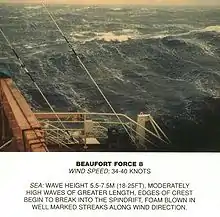Spindrift
Spindrift (more rarely spoondrift)[1] usually refers to spray, particularly to the spray blown from cresting waves during a gale. This spray, which "drifts" in the direction of the gale, is one of the characteristics of a wind speed of 8 Beaufort and higher at sea.

| Look up spindrift in Wiktionary, the free dictionary. |
In Great Britain "spindrift" is the telltale sign used by mariners to define a Force 8 (Beaufort Scale) wind (not higher) when observed at sea. See this example of information provided by Lymington Harbour authority, Hampshire, England, UK, explaining the whole scale, the associated wind speeds, and its telltale signs. Text from the site[2] states:
Force 8, defined as "Gale". Wind speed 39-46 mph, equal to 34-40 knots. Inland, twigs break off trees; progress generally impeded. At sea, moderately high waves of greater length; edges of crests begin to break into spindrift; foam is blown in well-marked streaks along the direction of the wind.
Relatedly, spindrift can also be used to describe fine sand or snow that is blown off by the wind.[3]
Spindrift is a southern English word, Spoondrift a northern or Scottish word. The Scottish word spoondrift can be used to describe fine snow that is blown off the hills by the wind.
Some sources[4] regard "spoondrift" as a direct alternative to "spindrift" in all its uses.
In US Navy during WWII there is evidence [5]that spindrift and spoondrift were distinct terms used for different phenomenon. As the Captain of the USS Barb (SS-220) states on her 10th War Patrol:
Visibility--which had been fair on the surface after moonrise--was now exceedingly poor due to spoondrift. Would that it were only the windblown froth of spindrift rather than the wind-driven cloudburst of water lashing the periscope exit eyepiece. This was a surprise feature I hadn't counted on. -Captain Eugene B. Fluckey
In Greek and Roman mythology, Leucothea is considered the goddess of spindrift.[6]
In popular culture
The trans-orbital transport spacecraft in Irwin Allen's 1968 television series Land of the Giants was called Spindrift.
The progressive rock band Rush references the phenomenon in the song Spindrift on their 2007 album Snakes and Arrows with lyrics that describe "spray that's torn away".[7]
Spindrift is mentioned as stinging the singers remaining eye in the opening lines of the Half-Man Half-Biscuit song "National Shite Day". [8]
References
- Shorter Oxford English dictionary. United Kingdom: Oxford University Press. 2007. p. 3804. ISBN 978-0199206872.
- "Archived copy". Archived from the original on 2011-09-27. Retrieved 2011-12-14.CS1 maint: archived copy as title (link)
- Spindrift entry on Merriam Webster. Retrieved 20 July 2008.
- http://www.crosswordsolver.org/definition/S/spoondrift
- Thunder Below!. United States of America: the Board of Trustees of the University of Illinois. 1992. pp. 188, 189. ISBN 978-0-252-06670-2.
- See footnote 117 in Marcel Proust, In the Shadow of Young Girls in Flower, trans. James Grieve (New York: Penguin Books, 2002).
- Body, Alex E. (20 June 2019). Rush : song by song. [Stroud, Gloucestershire, England]. pp. chapter 18. ISBN 978-1-78155-729-7. OCLC 1088907970.
- https://www.musixmatch.com/lyrics/Half-Man-Half-Biscuit/National-Shite-Day
